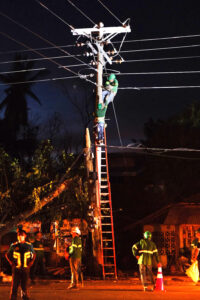To avoid another Ondoy, a disaster resilience warned that interventions need to be customized according to each city’s needs. There is no “one size fits all” solution.
Guillermo Luz, chief resilience officer of non-profit Philippine Disaster Resilience Foundation (PDRF), said that measures could be a combination of engineering interventions, infrastructure upgrades, or nature-based solutions to avoid runoffs from Sierra Madre.
The so-called evacuation centers in the Philippines are facilities that are not originally designed to be evacuation centers. Schools, basketball courts, and government buildings become evacuation centers when disasters hit.
“It’s important to kind of look at alternative sites and build evacuation centers – not always using our schools.… You don’t want to evacuate people into another area that’s still at risk. So we have to identify and build centers in areas which are low for hazards,” Luz said.
Metro Manila also faces earthquake-related hazards aside from flooding, as the West Valley Fault runs under the metropolis.
In March, the House of Representatives had submitted to the Senate the third reading copy of House Bill (HB) No. 7354, which, if passed into law, would mandate every city and municipality to have a permanent evacuation center. Thirteen cities in Metro Manila currently do not have one.
According to a discussion paper by the Congressional Policy and Budget Research Department at the Lower House, one evacuation center that meets all the requirements of the bill would cost each Metro Manila local government unit (LGU) at least P65.7 million ($1.16 million)*.
If a structure were to be upgraded to be a permanent evacuation center, the cost starts at P49.3 million ($870,000). While Metro Manila has some of the wealthiest cities in the Philippines, the price tag is considerably high.
If lawmakers get their way, construction of, and upgrade to, permanent evacuation centers would be shouldered by the national government.
Pumping stations cannot drain water fast enough
Apart from evacuation centers, Luz said that addressing drainage problems in the metropolis is of paramount importance. Metro Manila also needs more pumping stations to move water from submerged areas to prevent or reduce flooding faster.
“Floods occur not only during a typhoon, but during actual heavy rainfall now without having to hit typhoon status. I think one of the root problems is the drainage situation within Metro Manila,” Luz said.
At present, if another Ondoy struck the capital, Manila would turn into a “river.”
The Metro Manila Development Authority (MMDA) runs 71 pumping stations to reduce flooding. The city of Manila houses the highest number of pumping stations at 27, followed by Malabon City at 16. But it is not enough.
The MMDA and the Department of Public Works and Highways (DPWH), with a loan from the World Bank and the Asian Infrastructure Investment Bank, are building 20 new pumping stations and rehabilitating 36 existing ones through the $500-million Metro Manila Flood Management Project.
It also aims to clean waterways and drainage channels, build new drains if needed, and introduce solid waste management programs in barangays. Some 2,500 families living near waterways will be relocated.
The project is set to close in November, six years after it became effective. But as of February, only three of 36 pumping stations have completed upgrades and 10 are ongoing rehabilitation. Four of the 20 new ones are set to be bidded out.
In a message, MMDA Chairman Romando Artes said that “the loan facility will probably be extended for another two years.” Artes had previously said that the loan has to be restructured and that the government was also proposing that the World Bank fund a 50-year drainage system master plan.
In a congressional oversight hearing on March 12, Senator Sherwin Gatchalian called out MMDA and DPWH, saying that the agencies need to play catch up given the prospect of La Niña in the latter half of the year.
Gatchalian pointed out that low-lying Navotas City has recently inaugurated new pumping stations built using its own funds. He asked DPWH: “If a local government can implement pumping stations right away, what seems to be the bottleneck in implementing pumping stations related to this project?”
DPWH Senior Undersecretary Emil Sadain responded that under the restructured program, the department will rehabilitate a total of 26 pumping stations and build only four – as opposed to the initial target of 36 and 20 pumping stations, respectively. Only 600 of the targeted 2,500 families will be relocated. In effect, the Philippine government reduced its targets to reach them.
Sadain explained that the coronavirus pandemic was among the reasons why the loan-funded project was delayed.
“We can still catch up the 30 (sic) pumping stations that are actually targeted for completion within the next two years,” the public works official said, giving assurances.
In the meantime, according to Sadain, the DPWH has built nine pumping stations using its budget.
A long way to go in preparedness
Since Ondoy and Typhoon Yolanda (Haiyan), Luz said Metro Manila has seen a lot of progress in terms of disaster prevention. But a lot still needs to be done.
“I think one of the lessons we all learned as a country after that is the investment in preparedness and prevention. Right now, we have a lot less human lives lost since Yolanda. And there are many times actually that we have storms where zero lives are lost and I think that’s a good sign of progress,” Luz said.
The disaster resilience expert said that local governments have started investing in emergency operations and command centers, but at some point, there will be too many.
“To really kind of feel the full benefit of these centers, they should be connected to each other.… If you have connectivity to another network or sister center (in another city), then at least you still have your information intact, then you can somehow figure out a way to tap into the information,” Luz said.
“So I think the next big [step] is really sharing all the information. In disaster response and even in preparedness and prevention, it’s important that everyone sees the same picture,” he added.
He also said that mayors should invest in updated hazard maps and look at flood models to determine the most vulnerable areas and ensure that “those are always free and clear” of risks. Since Ondoy, damage to houses and infrastructure has significantly gone down but thousands of people remain affected, disrupting livelihood and schooling.
On an individual level, Luz said that Filipinos only have to do the bare minimum as citizens. First is to pay attention to weather reports and second is to be mindful of their trash.
To prepare households for floods or disasters, Luz suggested using PDRF’s PH72 as a guide, a simple tool adapted from San Francisco’s SF72, which details how people can prepare for the first 72 hours of a disaster. It includes information on what supplies to prepare and planning how to meet your family should you get separated during an emergency.
Similar to PH72, the Torreses of Marikina have devised their own system during disasters. For them, one can never be too complacent.
“Be ready at all times. Don’t ever think that your area will not be flooded,” Reizan said. “Each family member should know what to do. Prepare your documents. Ready your clothes and belongings. Save some money. You can never really rely on anyone but yourself.” – Rappler.com
*$1 = P56.60
All quotes were translated into English.
Vianca Jasmin Anglo is a data analyst pursuing a postgraduate degree in Human Development and Services. She was part of the public health, pandemic management, and response in the Philippines. Her years of experience in social development demonstrate her commitment to human well-being through data analysis.
Reporting for this story was supported by the Environmental Data Journalism Academy – a program of Internews’ Earth Journalism Network and Thibi.
METHODOLOGY
This data story examined the link between evacuation centers and flood risk in Metro Manila. We obtained the latest evacuation center data from the DILG – which appeared incomplete – and supplemented it with 2021 data from the OCD. Capacity information from these lists are incomplete, limiting our analysis to the evacuation center-to-population ratio.
Using spatial software and Google Sheets, spatial analysis was conducted to pinpoint the intersection between evacuation centers and their corresponding flood susceptibility category from HazardHunterPH. For the full description of our methodology, please read it here. Data cleaning and analysis can be accessed here. This story was a result of collaboration between the author, and the data and story mentors from Thibi, Thet Win Htut, and Aika Rey, respectively.
Article by Vianca Jasmin Anglo | Rappler



